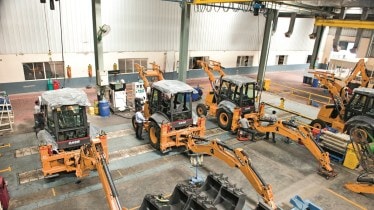The Indian construction equipment industry has been growing in high double-digit growth over the last several quarters. In fact, as per the latest data shared by the Indian Construction Equipment Manufacturers Association (ICEMA), the apex body representing the industry, in Q3 FY2024, the industry clocked sales of 36,055 units, which was 30 percent higher YoY.
In a recent conversation with Financial Express Online, Shalabh Chaturvedi, MD, CASE Construction – India & SAARC, spoke on a range of topics from the impact of the pandemic on the global construction equipment industry, India market, impact of elections and the expectation of pre-buying due to the upcoming CEV 5 emission norms.
He stated that post-pandemic governments across the world used the infrastructure route to boost the economy and countries like India are reaping rich dividends. “In the case of India, it sustained as we have infrastructure deficit, thus leading to a multiplier effect not just for the construction equipment, but the consequential industry like commercial vehicles and many other sectors which are aligned with that. For construction equipment specifically, the growth has been in the range of 15-20% in the last 2-3 years YoY,” stated Chaturvedi. In fact, cumulatively the industry has nearly grown 50% since the time of the pandemic, he added.
Election impact
However, the ongoing elections could be a dampener to the momentum. He agreed that there is “a noticeable dip” in construction equipment activity during election years, with both the pre-election and post-election periods typically showing bullish trends.
Then post-election results, the new government often seeks to make significant strides within the first 100 days to set the tone for their upcoming term.
“However, this year is somewhat unique and perplexing. While one would expect a slowdown due to elections, there are also other factors at play. Notably, the construction equipment industry is gearing up for the transition to Stage 5 emission norms, effective from January 1, 2025. While Stage 5 primarily impacts the tractor industry, it’s crucial for the construction equipment sector as well, denoted as CEV 5 (Construction Equipment Vehicle 5). This means that most of the equipment is going to get more expensive in CY25 Vs CY24, which should advance some of the buying from next year to this year,” explained Chaturvedi (pictured above).
This year on the one hand will dampen the effect from the election, but a positive impact will come from the emission change. Therefore, while the industry may not be in the negative, it will also not be able to see the high double-digit growth either. “This year the growth can be kind of flattish with maybe a 5-10% growth or single-digit growth.”
Emission norm, impact on margins
The change in the emission norms is applicable for wheeled equipment – loader backhoes, vibratory compactors, and wheel loaders among others. The threshold currently is applicable for construction equipment vehicles in the above 50HP category, but in Stage 5, the threshold will become 25HP.
The delta impact on the cost of vehicles above 50HP will not be as significant as the construction equipment vehicle classes in the 25-50HP range, which at present constitutes sales for almost one-third of the market.
Chaturvedi pointed out that many of the equipment’s, especially the loader, backhoes are going in the rental industry or the hirers market. There is a certain hourly rate, which the hirer gets for the equipment for instance in the range of Rs 900 to 1000 an hour or if you go for the full month, it is about Rs 1 lakh. “Now, this rental is there because there is a large machine population which is of stage-III machines sold before 2021 which are still active.”
According to him the rental rates will continue to remain under pressure for some time until the Stage 3 machines get flushed out of the ecosystem. “We are trying to find ways and means on how we can try to compensate the some of the increases in the acquisition cost through reductions in the fuel consumption, so that the total cost of ownership on for rental operator on an hourly basis or a monthly basis still remains range bound.”
As per estimates, Stage 2 machines are likely to be exceedingly rare in India, with perhaps only a few still operational in some remote rural areas. However, “Stage 3 machines are still expected to constitute around 40% of the overall industry. The remaining portion would primarily consist of Stage 4 machines, which have been newly introduced in the last three years since 2021.” This he estimates will mean roughly 43-45 percent of predominantly Stage 3 machine owners to upgrade this year.
